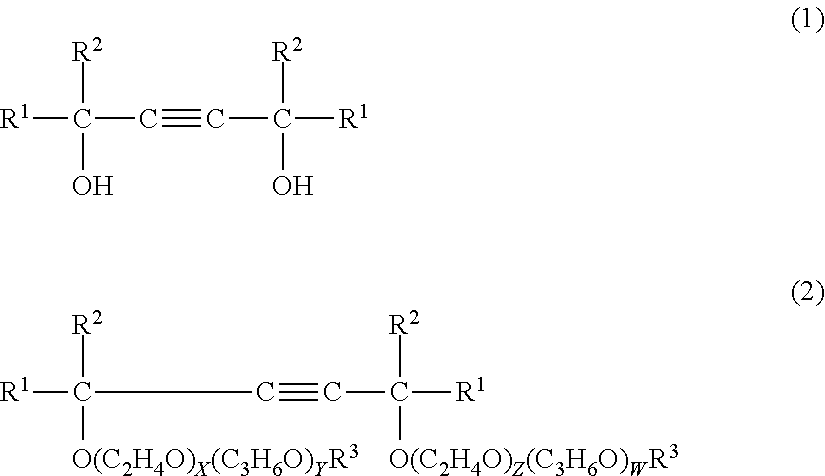Glass fiber-treating agent and glass fiber-treating composition
a technology of glass fiber and treasurant, applied in the field of glass fibertreating agent, can solve the problems of poor penetration of nonionic surfactants, many practical problems, and failure of coating surface, so as to reduce dynamic surface tension or contact angle, good wetting (or traveling) and penetrating properties, and low dynamic surface tension
- Summary
- Abstract
- Description
- Claims
- Application Information
AI Technical Summary
Benefits of technology
Problems solved by technology
Method used
Image
Examples
example 1
[0044]Into a vessel equipped with a propeller agitator was fed 55 parts of 2,4,7,9-tetramethyl-5-decyne-4,7-diol (trade name Surfynol 104 by Air Products and Chemicals Inc.) heated at 70° C. With agitation, 45 parts of a polyoxyalkylene-modified silicone (polyoxyethylene content: 47.3%) of the formula (4):
was slowly added and mixed. After 2 hours of continuous agitation, the mixture was cooled to room temperature.
[0045]After cooling, the mixture was filtered through a 200-mesh fabric filter, yielding a glass fiber-treating agent, designated M-1.
[0046]Then, 0.1 part of the glass fiber-treating agent M-1 was added to 100 parts of deionized water, which was stirred by means of a magnetic stirrer into a 0.1% aqueous solution. The aqueous solution was examined for outer appearance, contact angle, dynamic and static surface tensions under the test conditions shown below. The results are shown in Table 2.
[0047]Also, using the glass fiber-treating agent M-1, a binder aqueous solution and a ...
PUM
| Property | Measurement | Unit |
|---|---|---|
| weight | aaaaa | aaaaa |
| total weight | aaaaa | aaaaa |
| modulus | aaaaa | aaaaa |
Abstract
Description
Claims
Application Information
 Login to View More
Login to View More - R&D
- Intellectual Property
- Life Sciences
- Materials
- Tech Scout
- Unparalleled Data Quality
- Higher Quality Content
- 60% Fewer Hallucinations
Browse by: Latest US Patents, China's latest patents, Technical Efficacy Thesaurus, Application Domain, Technology Topic, Popular Technical Reports.
© 2025 PatSnap. All rights reserved.Legal|Privacy policy|Modern Slavery Act Transparency Statement|Sitemap|About US| Contact US: help@patsnap.com



